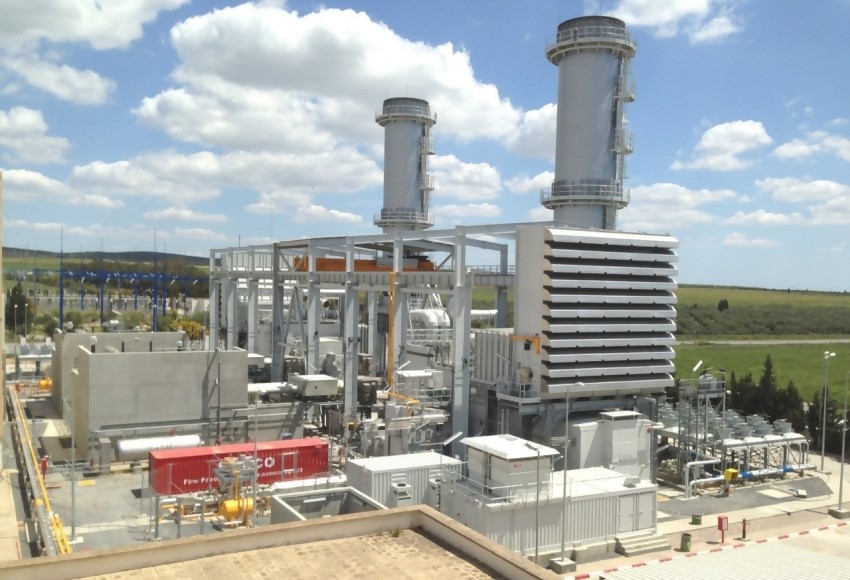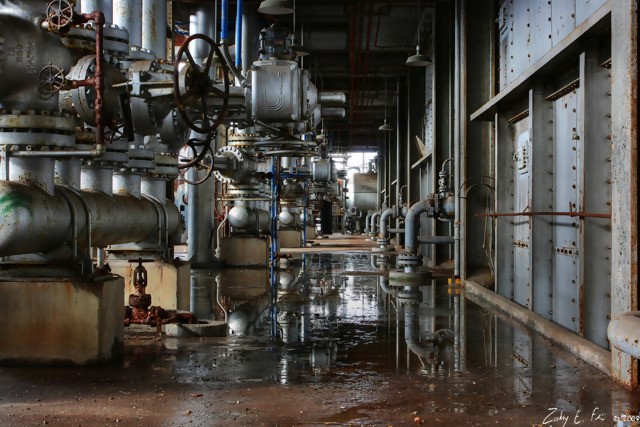A P R I M E R
Building Large Electrical Power Plants
Conventional Approach

The design and construction of large electrical power plants worldwide is an enormous and expensive business. These extremely necessary projects are, in many cases, the first steps taken in building a major development in a remote area (mining venture, military base etc.) or in a developing and/or rapidly growing country. More and more, for convenience and environmental considerations, these power plants have and are being designed around natural gas as the fuel of choice. Huge, technically sophisticated companies like General Electric, Siemens, Mitsubishi, etc. have filled this role by designing more and more gas turbine generators for both "peaking" power needs and continuous base load generating capacity. These power plants are built at strategic locations or along an electrical grid for final power distribution.
These gas turbines are basically massive jet engines mounted in a “frame” i.e. GE Frame 9, GE Frame 7 etc. and turned on their side. The shaft extending from the turbine blades turns a gear box and the large connected electrical generator. The generator can be either 50 Hz or 60 Hz depending on the country’s electrical system. The units are now outfitted with extremely efficient control systems that burn natural gas and other petroleum products very efficiently. As a practical matter these plants/turbines are dual fueled and can and do burn diesel fuel and/or light crude oil as well. It should be noted that the use of diesel fuel instead of natural gas will normally increase the fuel consumption by approximately 5% for new or remanufactured units.
In addition, it is common practice in most modern large plant designs to make these plants even more efficient by capturing the waste heat in the exhaust gases. The waste heat emanating from these gas turbines is converted to steam in huge; “heat-recovery and steam- generation” (HRSG) units. This earlier waste heat, now converted to steam is routed to a nearby steam turbine(s), which allows the production of up to 50 percent more electricity from the same fuel than a traditional “simple-cycle” plant. This process is referred to as “combined cycle” (CC) electrical generation and from an engineering and environmental perspective is extremely efficient. These units are normally designated with the short hand of GTCC meaning “gas turbine in combined cycle”. When the turbines are not paired with the HRSG and steam turbine units they are referred to as being in “single-cycle or “simple-cycle”.
These projects come with a cost. These power plants, by necessity are quite large 100 to 1,000-plus Megawatts (MW) and cost new approximately $1.0 to $1.4 million per MW installed, depending on location and size. In addition they can take 3 to 5 years to build even after all the design and engineering is completed and the hundreds of millions of dollars in financing are in place. The feasibility, design, engineering and financing alone can take two to four years. The longest lead time in the construction process is the manufacture of the gas turbines, which with the major manufacturers, is approximately 24 to 36 months. Normally 100% new equipment is required throughout. Ironically the same banks that are reluctant or refuse to finance remanufactured power plants, participate in financing the purchase of electrical power companies that own and operate 100% used equipment.
The consulting, design, engineering, purchasing, reviews, permitting, financing and construction issues are no less formidable. These projects, because of their tremendous scale and cost come under enormous scrutiny by owners, government agencies, credit enhancing agencies, lenders etc. Normally only a “select group” of the largest “name brand” consultants, engineers and manufacturers operate in this arena. The larger the project, the smaller will be the group of available participants. The extreme lead times on these projects require massive amounts of overhead just to examine plans, travel to remote locations, design equipment and prepare the cost estimates for projects in sometimes faraway places several years in advance. In addition, because of the money involved and project scrutiny, the financial, bonding and legal “requirements” just to be involved eliminates most companies. Unfortunately and maybe unintentionally, everyone in this “professional food chain” gets paid more money by taking longer and making the project more expensive. Regardless, the end result is that major electrical projects; take a very long time to build and are built by a select group of extremely large companies at enormously high prices.
Alternative Approach

Many knowledgeable customers know that buying and building power plants with partially remanufactured equipment can save enormous amounts of money without additional construction or performance risk. One of the secrets of the power generation business is that the basic equipment is very hardy and can last a very long time i.e. 40 to 50 plus years. These extremely expensive and long lead time components i.e. turbines, turbine blades, shafts, housings, gear boxes, generators etc. last lifetimes when properly maintained. In addition used AND brand new equipment must be torn apart, inspected and partially rebuilt approximately every four to six years. During the rebuild periods, bearings and seals and blades are replaced; all components are inspected visually and via ultrasonic testing (UT) for thickness along with dye penetrant (DP) testing for cracks and flaws. Normally the latest efficiency control hardware and software is also installed during these rebuilds. From an environmental perspective, remanufactured units can meet or exceed the emissions requirements for World Bank Standards.
Cost/Economics

Now the economics are totally different for used equipment. Used equipment, even slightly used equipment, is discounted severely. This is not that it is not extremely serviceable and valuable, but because the specific equipment may not be available for a particular time frame and the “remanufactured equipment” will very rarely be approved by all those, consultants, bureaucrats, engineers, lawyers and the many lenders. Some organizations prohibit the purchase of used and remanufactured equipment.
In addition much of this equipment has already been “paid for” by someone else and for a myriad of reasons is being dumped on the market. Major mining operations close down when commodity prices fall, military bases are closed for political reasons or merchant power plants go broke when fuel prices move unexpectedly in the wrong direction. When this happens, which is often enough, power plants/units enter the market at huge savings. The first problem is finding knowledgeable purchasers willing to look at these alternatives. In addition these purchasers must be matched with smart, honest and knowledgeable contractors to acquire this equipment, have it rebuilt/remanufactured and then match all the appropriate components and build a total package on the customer’s site. (At times complete plants can be purchased, remanufactured and relocated in their entirety). Both issues must be addressed, but the single most important consideration in this process is that these knowledgeable customers must have their own or alternative financing and be able to move with relative alacrity.
It should be noted that most rebuilt/remanufactured equipment in this area comes with a “zero hour warranty” (one year or 8,000 hours of operation) just like brand new equipment. Project savings, of 35% to 40% plus, are not unusual. Remanufactured equipment/plants sometimes come with large inventories of spare parts, complete plant designs and knowledgeable personnel. In addition the project quality may very likely be equal to or better than newly-built plants. Many times, used stainless components like tanks are used as substitutions for mild steel because they are available. Other components may generally be “oversized” because the larger size(s) were available and maybe at lower cost. All new electrical wiring and control cabling will be used throughout. Many other items like on site housing and or extra-large foundations may be added to overcome unforeseen site or labor problems. (It is often infinitely easier to use common sense and over-build to solve a problem than spend days, weeks or months fighting with design engineers etc. over change orders/cost items). Because the contractor is working directly with the owner, he wants to quickly build a great product and earn his trust. In addition, because of the huge savings achieved in buying the major components, and the reduced consulting, engineering and finance costs; putting the money onto the construction/project is easy and monetarily rewarding for all parties. Projects can be completed and online in about one third the time needed for all “new” facilities. These earlier start-up dates can also garner hundreds of millions of dollars per year in owner revenues.
As with all projects, the construction specifications will be more or less standard and controlled by international construction and electrical codes. Draw schedules, site inspections and payments can and will all be agreed to before a project is initiated.
Reliability Issues

Regarding reliability issues of “rebuilt/remanufactured” equipment vs “new” equipment, it is important to remember that remanufactured equipment delivered from qualified rebuild shops carry a “zero hour warranty” which is identical to a warranty on a brand new piece of equipment. These rebuild shops are owned and operated by companies like GE, Siemens etc. These warranties normally cover the first year of operation i.e. 12 months or 8000 operational hours, parts and service.
In addition there are many well qualified international companies that will enter into operations and maintenance service contracts to operate the equipment and keep qualified personnel on site at all times. This provides a second level of protection and these O&M contracts are relatively low cost in the great scheme of things.
Insurance can also be purchased for lost revenues, bad fuel, bad water quality, catastrophic failures etc. Like all insurance this is just a cost benefit peace of mind item, but available for both new and remanufactured plants.
End Product
Rebuilt plants have a few drawbacks. As mentioned earlier, the basic main hardware (turbines, generators etc. can last 40 to 50 plus years) so a remanufactured plant in theory will have a slightly lower life span say 30 -40 years vs 45-50 years for a new plant. In addition older plants/turbines may be slightly less efficient. As a frame of reference the latest and greatest gas turbines in combined cycle have a burn rate of approximately 6500 BTU per KWH. Older equipment will most likely be slightly less efficient, even after a rebuild and control upgrades; say 6700 to 7000 BTU per KWH. (This is still a very efficient burn rate).


